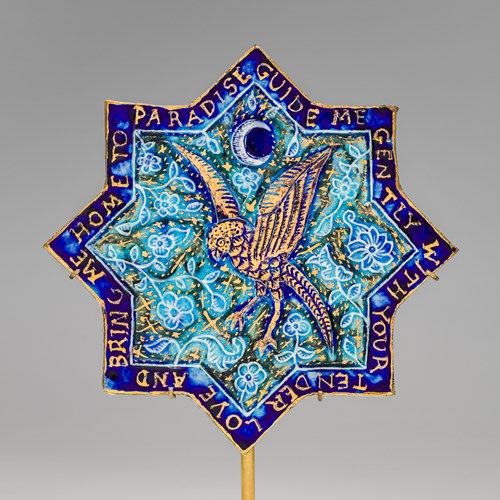Marketplace
Qajar Mirror
This elegant mirror stand made from steel, engraved and inlaid with gold damascene, dates from the Qajar period. The cusped round head, into which the mirror is set, sits atop the baluster-shaped leg, which rises from a bulbous, cusped foot. Gold damascene (koftgari) in vegetal patterns ornaments the steel throughout, examples of which can be seen on a selection of objects including bowls, jugs, and mirrors in Fellinger's L'Empire des roses.1 An eight-pointed rosette carved out of the hinged door of the mirror is decorated with openwork, including an inscription, legible only in certain lights, which reads:
السلطان ابن السلطان شاه عباس صفوی الموسوی بھادر خان خلد الله ملکھ الي یوم الدوران عمل حاجی ٩٩٢
The Sultan son of the Sultan, Shah ‘Abbas Safawi al-Musawi Bahadur Khan may God perpetuate his dominion until the day of fortune. The work of Haji, 992 (1584-5 CE).
This anachronistic date is suggestive of a maker wishing to associate his work with the glories of the early Safavid Era. It appears refer to Abbas I (r. 1588 - 1629), whose full name was Abu'l Muzaffar Abbas al-Husayni al-Musawi al-Safavi Bahadur Khan. However, the confused chronology and nomenclature suggests the aesthetic function, and the glory of assocation with Safavid Shahs, was of greater importance than the accuracy of the inscription.
When the mirror is opened, a lacquer painting is revealed on the inside of the door. In the central roundel is depicted a pair of lovers in a courtly setting. The man offers the woman a cup of wine, a motif seen in Safavid paintings (see MFA Boston accession no. 14.595). In line with stylistic conventions of classical Persian painting, emotion is not portrayed through facial expressions, rather, through action. In Qajar examples, the exchange of flowers, cups, and fruits serve as indicators of romantic intention.2 Two female attendants stand at the peripheries, holding bowls of refreshments, and a male attendant holds a huqqa pipe. A border is formed from alternating cartouches of roses and countryside scenes. One can imagine a courtly woman checking her reflection in the mirror, and getting lost in the depiction or romance and idyllic scenery.
A Qajar mirror stand in the British Museum (accession no. 1967,0718.1) dated to c. 1850 similarly features an eight-pointed star with an inscription in the openwork detail. It also opens to reveal a lacquer portrait, this time of Kay Khusrow, the legendary King from the Shahnameh.
1 Fellinger, G. et al. L'Empire des roses: chefs-d'œuvre de l'art persan du XIXe siècle. Gand: Snoeck, 2018. pp. 376-79. Cat. 372-77.
2 Chekhab-Abudaya, M., and Sobers-Khan, N. Qajar Women: Images of Women in 19th-Century Iran. Milan: Silvana Editoriale, 2016. pp. 118, 128.
السلطان ابن السلطان شاه عباس صفوی الموسوی بھادر خان خلد الله ملکھ الي یوم الدوران عمل حاجی ٩٩٢
The Sultan son of the Sultan, Shah ‘Abbas Safawi al-Musawi Bahadur Khan may God perpetuate his dominion until the day of fortune. The work of Haji, 992 (1584-5 CE).
This anachronistic date is suggestive of a maker wishing to associate his work with the glories of the early Safavid Era. It appears refer to Abbas I (r. 1588 - 1629), whose full name was Abu'l Muzaffar Abbas al-Husayni al-Musawi al-Safavi Bahadur Khan. However, the confused chronology and nomenclature suggests the aesthetic function, and the glory of assocation with Safavid Shahs, was of greater importance than the accuracy of the inscription.
When the mirror is opened, a lacquer painting is revealed on the inside of the door. In the central roundel is depicted a pair of lovers in a courtly setting. The man offers the woman a cup of wine, a motif seen in Safavid paintings (see MFA Boston accession no. 14.595). In line with stylistic conventions of classical Persian painting, emotion is not portrayed through facial expressions, rather, through action. In Qajar examples, the exchange of flowers, cups, and fruits serve as indicators of romantic intention.2 Two female attendants stand at the peripheries, holding bowls of refreshments, and a male attendant holds a huqqa pipe. A border is formed from alternating cartouches of roses and countryside scenes. One can imagine a courtly woman checking her reflection in the mirror, and getting lost in the depiction or romance and idyllic scenery.
A Qajar mirror stand in the British Museum (accession no. 1967,0718.1) dated to c. 1850 similarly features an eight-pointed star with an inscription in the openwork detail. It also opens to reveal a lacquer portrait, this time of Kay Khusrow, the legendary King from the Shahnameh.
1 Fellinger, G. et al. L'Empire des roses: chefs-d'œuvre de l'art persan du XIXe siècle. Gand: Snoeck, 2018. pp. 376-79. Cat. 372-77.
2 Chekhab-Abudaya, M., and Sobers-Khan, N. Qajar Women: Images of Women in 19th-Century Iran. Milan: Silvana Editoriale, 2016. pp. 118, 128.
More artworks from the Gallery









